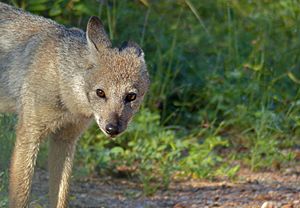Side-striped jackal facts for kids
Quick facts for kids Side-striped jackalTemporal range: Pliocene - recent
|
|
|---|---|
 |
|
| On the S131 Road West of Letaba, Kruger National Park, South Africa | |
| Conservation status | |
| Scientific classification | |
| Genus: |
Canis
|
| Species: |
adustus
|
 |
|
| Side-striped jackal range | |
The side-striped jackal (Canis adustus or Lupulella adusta) is a type of wild dog found in central and southern Africa. These animals usually live in areas with lots of trees, like woodlands, or in bushy scrublands. They are known for the light stripe along their sides.
Contents
What is a Side-Striped Jackal?
Side-striped jackals are part of the dog family, called canids. They are a bit smaller than wolves but larger than foxes. They get their name from the faint white stripe that runs along each side of their body. They also have a white tip on their tail.
Where Do They Live?
These jackals are found across a large part of Africa. Their home range stretches from West Africa, through Central Africa, and down into Southern Africa. They prefer places with trees and bushes, like savannas, woodlands, and even some forest edges. They usually avoid open grasslands or very dry deserts.
What Do They Eat?
Side-striped jackals are omnivores, which means they eat both plants and animals. Their diet changes depending on the season and what food is available. They often eat fruits, especially during the wet season. They also hunt small animals like insects, rodents, birds, and reptiles. Sometimes, they will eat eggs or even carrion (animals that are already dead).
Behavior and Life
Side-striped jackals are mostly active at night, which means they are nocturnal. They are generally shy animals and prefer to stay hidden.
Social Life
Unlike some other jackal species, side-striped jackals are not usually seen in large groups. They often live alone or in pairs. A pair might be a male and female who stay together to raise their young. They communicate with each other using different sounds, like howls and yelps.
Reproduction and Pups
Female side-striped jackals usually give birth to a litter of pups in a den. The den can be an old aardvark hole or a space under rocks. Both parents help to care for the young pups. The pups stay with their parents for several months, learning how to hunt and survive before they go off on their own.
Conservation Status
The side-striped jackal is currently listed as "Least Concern" by the International Union for Conservation of Nature (IUCN). This means that their population is stable and they are not considered to be in danger of extinction right now. However, like many wild animals, they can face threats from habitat loss as human populations grow.
Images for kids
-
In Kidepo National Park, Uganda
See also
 In Spanish: Chacal rayado para niños
In Spanish: Chacal rayado para niños




